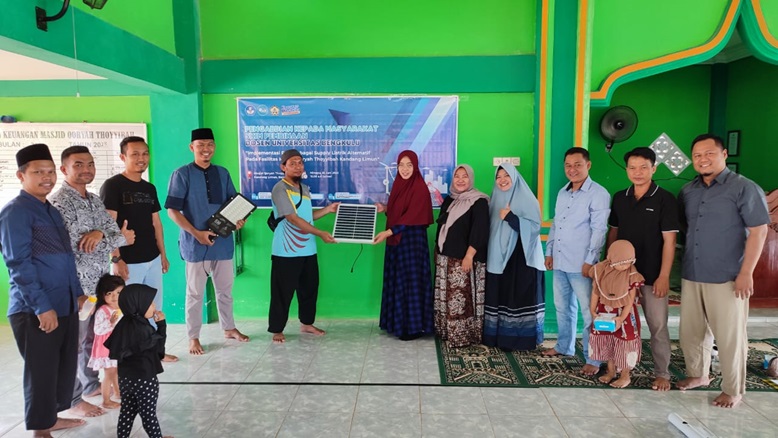Implementasi PLTS sebagai Supply Listrik Alternatif pada Fasilitas Masjid Qoryah Thoyyibah Kandang Limun Implementation of PLTS as an Alternative Electricity Supply at Kandang Limun Qoryah Thoyyibah Mosque Facilities
Main Article Content
Abstract
The Government of the Republic of Indonesia has long encouraged the use of renewable energy, but in fact there are still many people who use primary energy. Seeing this, the idea emerged from the Community Service Team by Bengkulu University lecturers to design and implement Solar Power Plants (PLTS). This renewable energy idea was implemented at the Qoryah Thoyyibah mosque, Kandang Limun Kota Bengkulu. The purpose of this service is the implementation of Appropriate Technology, namely PLTS for alternative energy supply at the Qoryah Thoyibah Mosque facility. So that if there is a power outage by PLN, the facilities at the Qoryah Thoyyibah Mosque can still operate according to their functions. This service method is carried out by two methods, namely counseling and implementation of PLTS Appropriate Technology. It is hoped that in the future by designing and building PLTS as an alternative energy source at the Qoryah Thoyyibah Kandang Limun mosque in Bengkulu City, the backup electricity supply will be fulfilled and we will not always depend on PLN, besides that it can also reduce the monthly cost of electricity at the Qoryah Thoyyibah Mosque. The result of Community Service activities with the 2023 Development scheme is that PLTS has been installed with an AC source to operate lighting lamps with a capacity of 100 WP for PLTS and lamps of 800 Watts. So that it can be operated as a source of lighting for Qoryah Thoyyibah mosque facilities in a state where there is no source from PLN.
Downloads
Article Details

This work is licensed under a Creative Commons Attribution-ShareAlike 4.0 International License.
Authors who publish with this journal agree to the following terms:
- Any article on the copyright is retained by the author(s).
- Author grant the journal, right of first publication with the work simultaneously licensed under a Creative Commons Attribution License that allows others to share work with acknowledgment of the work authors and initial publications in this journal.
- Authors are able to enter into a separate, additional contractual arrangements for non-exclusive distribution of published articles of work (eg, post-institutional repository) or publish it in a book, with acknowledgment of its initial publication in this journal.
- Authors are permitted and encouraged to post their work online (e.g., in institutional repositories or on their websites) prior to and during the submission process, as can lead to productive exchanges, as well as earlier and greater citation of published work.
- The article and any associated published material is distributed under the Creative Commons Attribution-ShareAlike 4.0 International License
References
Adrianti. (2016). Evaluasi Keandalan Pembangkit Listrik Tenaga Surya yang Terhubung ke Grid. Jurnal Nasional Teknik Elektro. 5(2), p. 230. http://dx.doi.org/10.20449/jnte.v5i2.281
Anugrah, R. A., Wijaya, N. H. & Irfanudin, F. (2022). Edukasi Persyarikatan Muhammadiyah Tentang Instalasi Pembangkit Listrik Tenaga Surya Untuk Penerangan Masjid. Prosiding Seminar Nasional Program Pengabdian Masyarakat. pp. 2326–2332. https://doi.org/10.18196/ppm.46.833
Artiningrum, T. and Havianto, J. (2019). Meningkatkan Peran Energi Bersih Lewat Pemanfaatan Sinar Matahari. Geoplanart. 2(2), pp. 100–115.
Bachtiar, M. (2006). Prosedur Perancangan Sistem Pembangkit Listrik Tenaga Surya Untuk Perumahan (Solar Home System). Jurnal SMARTek. 4(3), pp. 176–182. Available at: https://media.neliti.com/media/publications/221906-prosedur-perancangan-sistem-pembangkit-l.pdf.
Bakhtiar, & Ruslan L. (2024). Desain Hibrid PLN-PLTS Dengan Instalasi DC di Masjid Uwais Al Qarni Sudiang Makassar. Prosiding Seminar Nasional Terapan Riset Inovatif (SENTRINOV), 9(1), 532 - 540. Retrieved from https://proceeding.isas.or.id/index.php/sentrinov/article/view/1328
Burhandono, Ardian; Sinaga, N. (2022). Menjaga Keandalan Sistem PLTS dengan Metode Failure Mode Effect Analysis (FMEA)’, Jurnal Teknik Industri. 12(1), pp. 30–39. https://doi.org/10.25105/jti.v12i1.13958
Eka Saputra. (2020). Profil Masjid Qoryah Thoyyibah Kandang Limun Bengkulu’, in Takmir Masjid Qoryah Thoyyibah (ed.) Profil Masjid Qoryah Thoyyibah Kandang Limun Bengkulu. 1st edn. Bengkulu: Masjid Qoryah Thoyyibah Bengkulu, pp. 1–20.
Handayani, Y. S., Alex Surapati & Fitrilina. (2022). Implementasi Small PLTS Pada Rumah Charging Sebagai Upaya Pengembangan Wisata di Desa Rindu Hati. Dharma Raflesia : Jurnal Ilmiah Pengembangan dan Penerapan IPTEKS, 20(2), pp. 352–364. https://doi.org/10.33369/dr.v20i2.24535
Kelurahan Kandang Limun. (2020). Profil Kelurahan Kandang Limun’, in Kelurahan Kandang Limun Bengkulu (ed.). Bengkulu: Kelurahan Kandang Limun Kecamatan Muara Bangkahulu Kota Bengkulu Provinsi Bengkulu, pp. 1–60.
Mayangsari, R. & Yuhendri, M. (2023). Sistem Kontrol dan Monitoring Pembangkit Listrik Tenaga Surya Berbasis Human Machine Interface dan Internet of Thing. JTEIN: Jurnal Teknik Elektro Indonesia, 4(2), pp. 738–749..
Mayasari, F. et al. (2022). Pengenalan Panel Surya sebagai Salah Satu Sumber Energi Terbarukan untuk Pembelajaran di SMA Negeri 1 Takalar. JURNAL TEPAT: Teknologi Terapan untuk Pengabdian Masyarakat, 5(2), pp. 147–159. https://doi.org/10.25042/jurnal_tepat.v5i2.271
Nugraha, I. M. A. (2020). Penggunaan Pembangkit Listrik Tenaga Surya Sebagai Sumber Energi Pada Kapal Nelayan: Suatu Kajian Literatur. Jurnal Sumberdaya Akuatik Indopasifik, 4(2), p. 101.
Nurjaman, H. B. and Purnama, T. (2022). Pembangkit Listrik Tenaga Surya (PLTS) Sebagai Solusi Energi Terbarukan Rumah Tangga. Jurnal Edukasi Elektro, 6(2), pp. 136–142. http://dx.doi.org/10.21831/jee.v6i2.51617
Pramana, P. et al. (2021). Revitalisasi Pembangkit Listrik Tenaga Surya (Plts) Pada Sistem Microgrid Pulau Tomia. Jurnal Technopreneur (JTech), 9(1), pp. 28–37. https://doi.org/10.30869/jtech.v9i1.724
Sofyan Muhammad. (2023). Analisa Perancangan PLTS Sebagai Sumber Energi Listrik Alternatif di SMK N 2 Tarakan. Universitas Borneo Tarakan.
